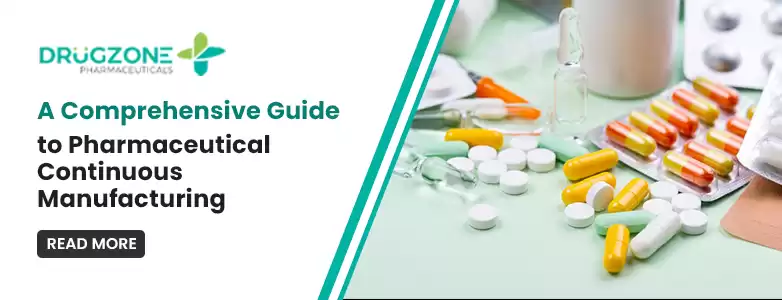
Posted On: April 03, 2024
A Comprehensive Guide to Pharmaceutical Continuous Manufacturing
After decades of using traditional batch processing, the pharmaceutical industry has recognized that with the shift to continuous manufacturing, it can gain significant improvements in efficiency, quality, and cost-effectiveness for production. In continuous manufacturing, there are real-time monitoring and control capabilities, which means lower error rates and less variability than in batch processing. And for drugs that need to be made by more than one large company, this marks a revolution. It allows pharmaceutical companies to stay better on top of changes in the market and regulatory environment, thus increasing their competitiveness for what lies ahead. It represents a new way of doing things that full-blown embraces continuous manufacturing. It promises to revolutionize drug production, and in the process will drive both innovation and higher efficacy of pharmaceutical production processes. This article provides a source of insight for regulatory professionals, pharmaceutical retailers, and hospital management seeking to understand and benefit from continuous manufacturing.
Continuous Manufacturing Overview
The continuous manufacture of pharmaceuticals denotes a process that proceeds in an automated and continuous sequence. This contrasts starkly with a batch operation, in which procedures are distinctly separated and there is long down-time between stages. It is an embodiment of the relentless drive for efficiency and technological progress that has now entered pharmaceuticals as one of its very important developments.
Continuous Manufacturing Benefits
· Consistent Quality: real-time monitoring with consistently high-quality products; you can adjust parameters immediately so as not to suffer from poor thermodynamic equilibrium.
· Higher Efficiency: idle periods are reduced and production speed is increased, for faster market delivery.
· Cost Saving: less waste and more effective resource use mean savings in money for people who must keep costs down.
· Scalability: easier to expand or reduce capacity in response to fluctuations in market demand.
· Industry Support: the FDA has been encouraging push for adoption of continuous manufacturing in order to improve the quality of drugs.
Continuous Manufacturing Implementation
To adopt continuous manufacturing will require careful planning and investment in new technologies, as well as compliance with set standards. The following are some key aspects to bear in mind:
1. Technology Integration
· Process Analytical Technology (PAT): uses sensors and control systems to assure quality.
· Automation: automated systems improve reliability, reduce human input and minimize Carpal Tunnel Syndrome.
2. Plant Design
. Modular Design: builds with maximum flexibility and adaptation to meet the needs of different products.
. Cross-contamination Control: ways to stop products mixing unseen between adjacent processes.
Regulatory Compliance
· Guideline Adherence: in line with whatever "Good Manufacturing Practices" the regulatory authorities most recently set out.
· Documentation and Validation: thorough record-keeping on process, validation and quality assurance matters.
3. Training the Workforce
Offers comprehensive training courses to operators and management staff members enabling them to adjust to new systems and technologies.
Challenges and Solutions
Despite all of the advantages that the transition might yield, challenges also await:
Regulatory Hurdles
· Solution: Engage the authorities early in the process to ensure they comply with you--and vice versa.
Investment Costs
· Solution: Make an economic tradeoff by looking at whether initial setup costs will pay off in long-term benefits.
Key Takeaways
· This new mode of manufacturing provides an opportunity to improve both efficiency and quality in pharmaceutical production.
· Early cooperation with regulatory bodies can facilitate smooth implementation.
· Investment in modern technology and staff training is essential.
Conclusion
The move to continuous manufacturing is changing the shape of the pharmaceutical industry, requiring an all-stakeholder approach pharmacy wholesaler suppliers, pharmaceutical retailers, and hospital managers working within this industry need to understand this transition in order to stay competitive in a market where consistent innovation is necessary, while maintaining that highest possible standard of safety and performance for clients.
FAQ
Q. Does continuous manufacturing improve your product quality?
Continuous manufacturing incorporates advanced monitoring and control technologies that ensure the product is of consistent quality throughout production. By largely eradicating human error and minimizing other uncontrollable problems we have achieved pharmaceutical manufacturing standards that are indeed unequaled anywhere else.
Q. What will be the economic payoff of going over to continuous manufacturing?
By adopting continuous manufacturing methods costs in raw material use and energy consumption can be greatly reduced. Clients benefit ultimately from ideal pricing structures as these efficiencies bring cost advantages.
Q. What are the benefits of continuous over batch production qc?
CM offers considerable advantages in terms of efficiency, product quality, production time reduction, and fewer chances for human error. In this continuous process, a lot can be determined with supervisory feedback; we are free before the next.








